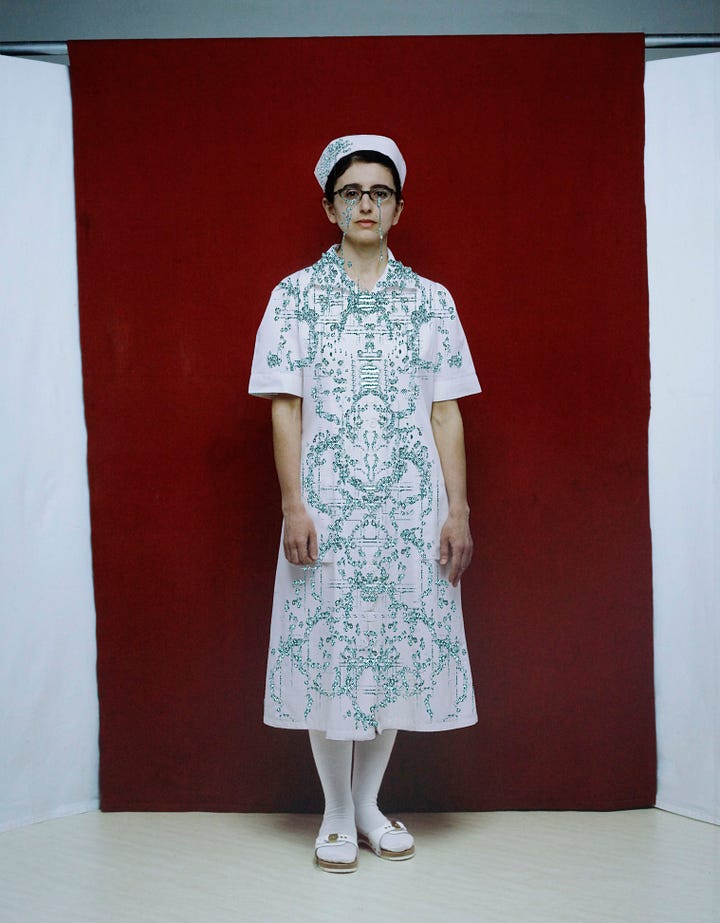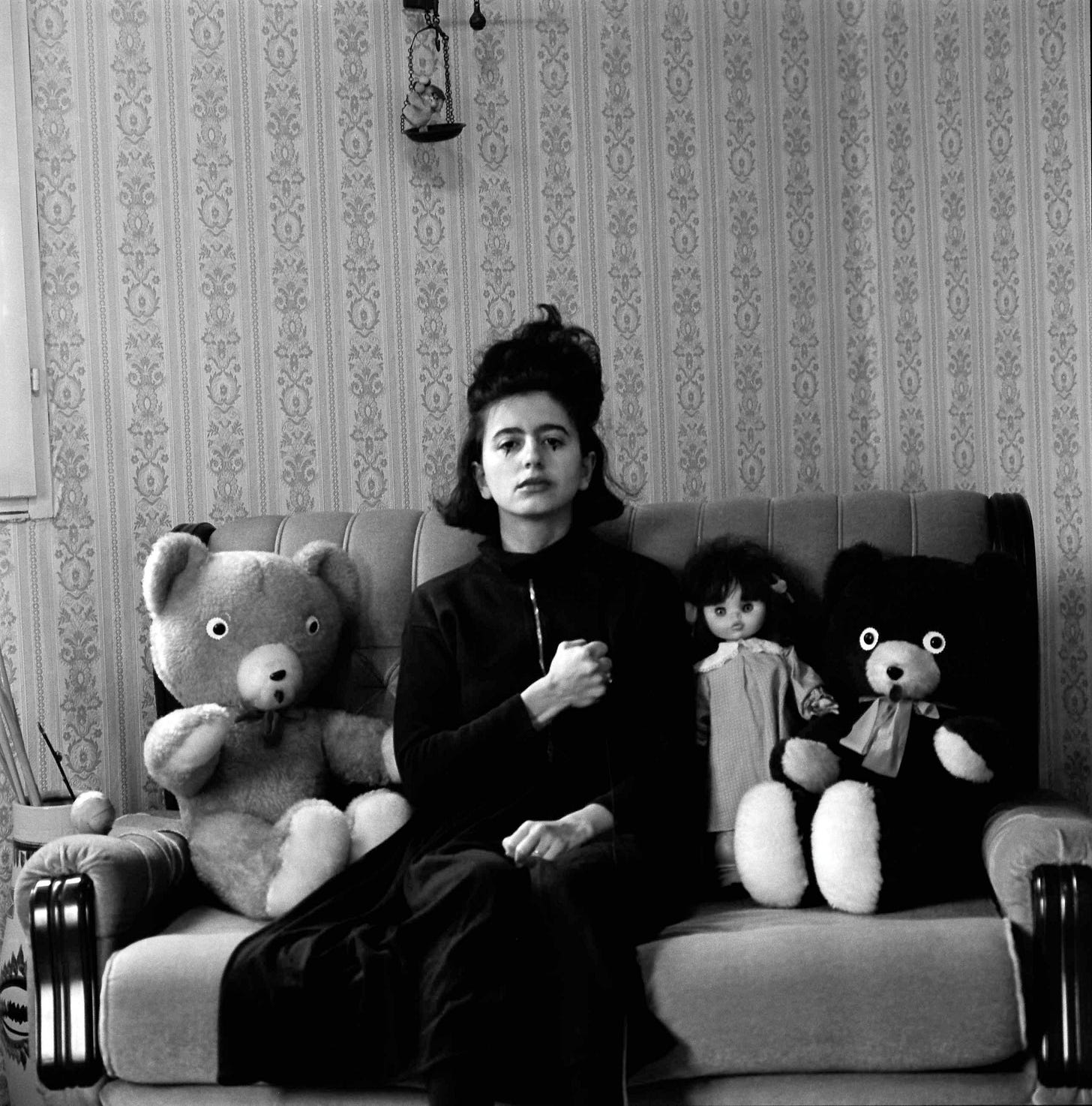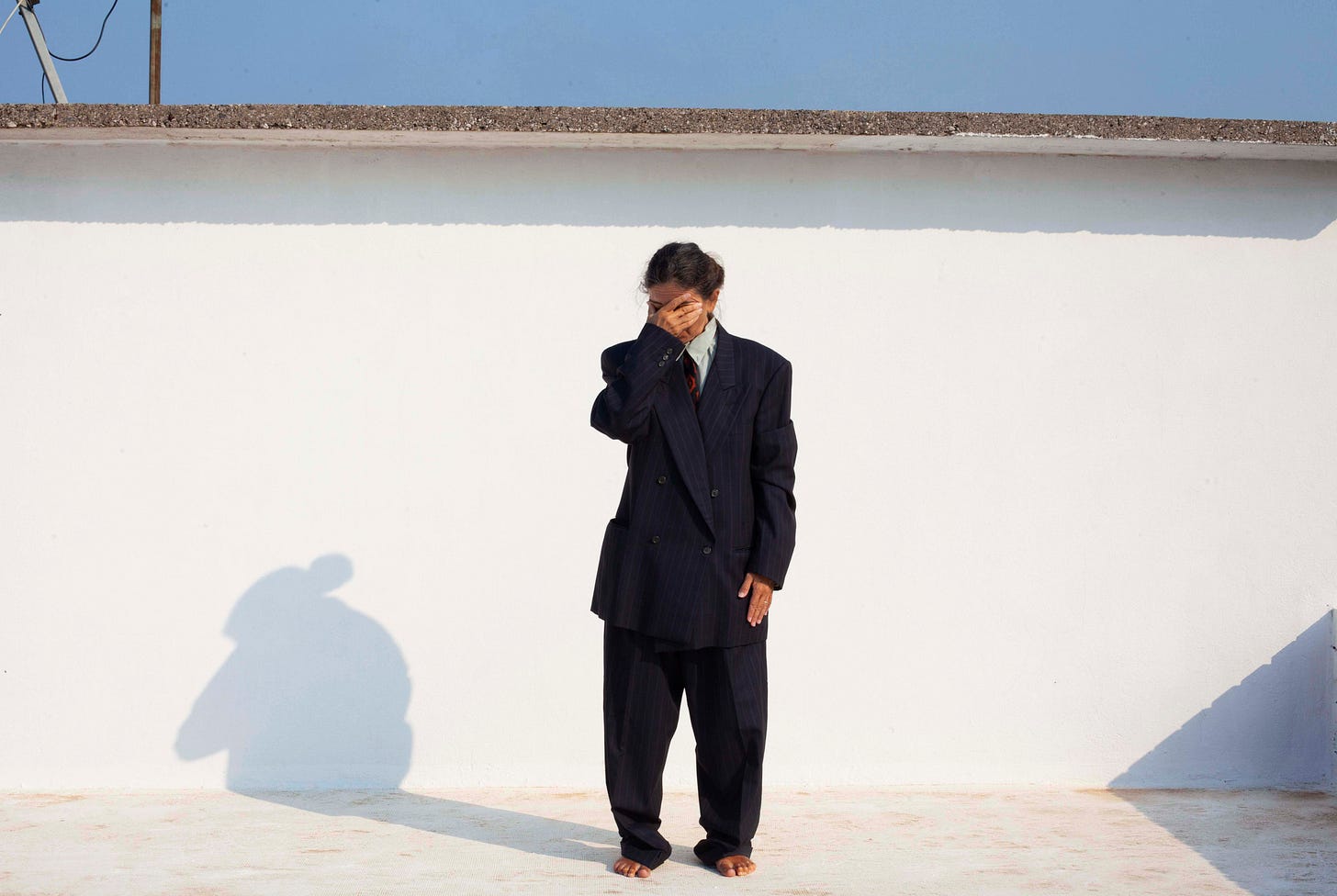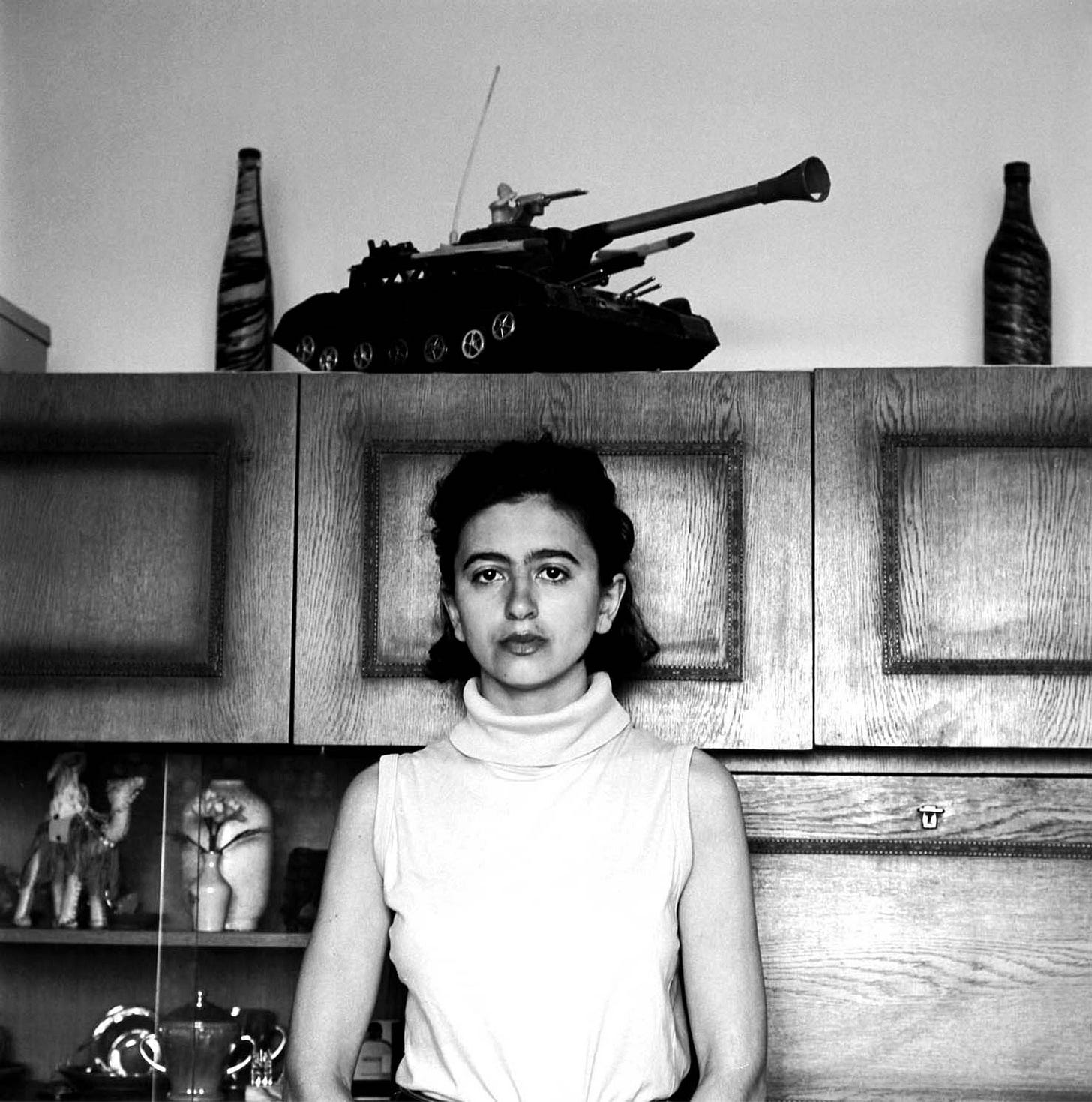The Self-Portrait
A conversation with Tarantula: Authors And Art's Inspiration for April, Snežana Vučetić Bohm
Snežana Vučetić Bohm, is a female photographer who doesn’t hide. On the contrary, she takes center stage in her photographs. She is her own inspiration and guide, comprehending her life experiences and environment. When she stumbles upon a location that piques her interests, such as a place from her childhood or ancestry, or one that reflects a new state of mind or body, like the time she was with child, she intuitively adds details to deepen the narrative of the space. For instance, she might include a mini toy-tank, transforming her family room into a set before clicking the push button to freeze the moment and birth a self-portrait.
It is not uncommon for women artist to embrace the form of self-portrait. It was first seen in the 15th century when female painters with no circumstances to have models to paint or to express their own stories took matters into their own hands. And as someone who moved from her country of birth, former Yugoslavia to Sweden at the tender age of two, with her family being among the first to come in the then-homogeneous Sweden as working migrants, it is not surprising that she chose to take control of her life's DNA and story. As someone who belonged to both worlds, or in-between worlds, she wanted to be seen, in all her glory, playfulness and complicity. Despite the fact that her male colleagues and journalists at times refused to give her space because she may have been too much in their faces or not appreciated because of the form she chose to express herself, she stares back at them in her self-portrait, with intensity and, at times, sadness in her eyes, never lowering her gaze to succumb to their definitions of her.
Snežana is the protagonist of the movie of her life, she is her own heroine in pursuing to tell the tales of her own identity and misconceptions. This is her art and her story.
Maja Milanovic: What is your first memory of art?
Snežana Vučetić Bohm: In my early twenties, I became acquainted with art through acting and the theatrical group, Sputnik, with which I was associated in the 1980s. We mostly performed modern plays, but performance was how I became involved with art later on. My first memory of being creative and doing stuff with my hands was cutting out pictures from fashion and hairstyle magazines. I created collages for my parents' hair salon, which they would hang in the shop window. I remember helping them clean the floor from hair. I wanted to be a dancer and sing in musicals, but due to a congenital hip injury, I was unable to pursue this.
My first real-life interaction with an artwork took place in 1991, when I saw Anselm Kiefer at Berlin's Neue Nationalgalerie. The life-size scale of an airplane in lead, as well as his personal post-Germany history, had a lasting impression on me. Later, while studying photography at art school, I found artists such as Diane Arbus, Mona Hatoum, and Marina Abramović. Abramović's performance "Lips of Thomas" from 1975, with the five-pointed star carved into her stomach, had a major impact on me.
As a photographer you often mix the personal and the public, what’s the role of your family in becoming an artist?
Art wasn’t present in the home where I grew up, at least not, western art history. Except for a few romantic reproductions we had. Back in former Yugoslavia you were not even allowed to have religious icons at home, although my mother hid them secretly in the drawer.
I grew up in a home of spirituality and oral storytelling. I would say that my parents really backed me up with their bodies and souls. Being the generation surviving WWII and growing up in a country where communism was taught to be the role model, they wanted me to have the kind of freedom they never had. For a while, they wanted me to take over their hairdressing business or become a lawyer. I hated hair, and I felt quite alienated from the educational system. Coming from a working-class background, I simply felt I didn’t belong in the academic world. I know my father had a true talent for poetry and folk dance. On my mother’s side, they had a tradition of singing. When my grandfather used his high vocal tone, which he was famous for, my mom and her four siblings began to follow suit. Everyone had their own tone of voice. Together, they sang and formed a family choir. On Saturdays, my father baked bread. I had my own performances for my family. Imitating and improvising pop singers or a scene from a musical. It has occurred to me that my parents must have been artists themselves somehow; without knowing it, they passed it on subconsciously. The dream, I mean. We practically made art at home without knowing we did.

Even though you moved to Sweden at the age of two, you continued to grapple with your Balkan heritage as well as feeling disconnected from your newly acquired Swedish identity. What role did photography play in your quest to find your place in the world?
Photography, as a discipline dealing with memory, was something I could relate to from childhood, I could get stuck for hours just looking at photo albums. When I went from theater and acting on stage to photography, I found myself in a new and free position. I used the camera as a witness to what I was experiencing at the time. I then turned the camera towards myself, using self-portraiture as a means of exploring identity and the environment around me. I found a way to play with or against the surroundings I was in. Improvising the situation of everyday life twisted with a little drama. I was interested in combining documentary photography with the concept of staged photography. I wanted to say that my photographs were imaginations of reality, not reality itself. I am still exploring my interest in subjects around themes of in-betweeness, belonging, and exile. Photography became and still is my foundation for this.
Working as a freelance photographer for many years took me to places I had never been before. I met people I didn’t know, nor would I have had the opportunity to have met them if it weren’t for photography. For this, I am thankful. I have collected images from my travels and archived them; today I use them for my collages.
As a child, I have thought about this. I must have made my first visual shots just by watching and gazing through the car window in the back of the seat. The trip to Yugoslavia took two and a half days, then back to Sweden again. We did these journeys every summer during my entire childhood. The reason for leaving our home in Yugoslavia was both political and personal. I would say, that my installation, titled Chevrolet Impala Custom from 1997, is the first work about my family history where I use not only photography but also one readymade. In the work, you can see my narrative embodied through this object, a cleaning cart on a high, red-painted podium with a parquet floor on top. You must stretch up high to be able to see the floor. Next to the high podium is a small low one, also in red, with a photograph from our family album showing me and my dad sitting on the front of our American car, the Chevrolet Impala Custom.
Your series “Self-portraits 1991-94,” from Sweden to Yugoslavia and back again and in-between there is autobahn" has won awards in Sweden and Europe. Despite the personal nature of self-portraits, how did viewers connect with your stories and what response did you receive?
They were well received in the 1990s, despite the two remarks I recall hearing from male journalists in Sweden's mainstream media: "this thing taking self-portraits is a simple way of doing photography," and "they are too private, so I don't want to publish them in my paper." Some of them were on display internationally and written about in academic papers. Then it got very quiet for two decades, until some of them started to show up in books celebrating jubilees at schools where I have studied. Just recently, a young visitor at the Moderna Museet in Stockholm made a drawing of one of my self-portraits. Amazing! My photographs live and breathe on their own. This makes me very happy.
Who were some of the people who inspired and supported you?
My parents, my family. Friends. Teachers. Artists. The world and everything around me, or just a line in a poem. This inspires me now: Endeavoring the unknown. Experience of vulnerability. Embracing chance.
In some of your portraits, you wear your mom and dad’s clothes, your aunt’s nurse uniform. Tell us a bit about that.
When I start working on a self-portrait or a new idea, I don’t know what I am looking for. I follow my curiosity and my intuition. The only thing I know is that the work must mean something to me. What I wear delves into the story and becomes the image itself. I try to weave our lives together. I see them as layers. An exercise in the process of bringing emotions to my body and the space I am in. I don’t automatically become my mother just because I wear her clothes, but the dress symbolizes something, a character showing a gesture or a role, which I am interested in exploring. It has meaning because I am wearing it. The process of the past, present, and future in the same image.


Your series Self Portrait as a Nurse started in 1996, you returned to it in 2010 and now again in 2023. Can you tell us a little bit about the project and why you returned back to it?
I see some of my works as timeless ongoing projects. I have them stored in my archives, and I use them as a point of departure to get them to be transformative and enter new rooms. In the same way as a theater play, it can be adapted, remade, and translated many times. In 1996, I was invited by Swedish Television to take a photograph of myself on location somewhere in Stockholm. The nurse was born on that assignment. She is my alter ego. I need the nurse to comfort me and hold me. The nurses’ story is different from my early self-portrait’s. For example, the profession of nursing involves taking care of the sick. In my work, she talks about feminism and the oppression of patriarchy. She struggles for women's rights, and she acts against violence and sexual abuse. The self-portraits are autobiographical, more about identity, vulnerability, and femininity; what is right for both is that they resist becoming objectified.
Maybe it wasn't a conscious decision when you started that project, but by returning to it, you're also chronicling your own life and the process of aging. Is it as easy to take self-portraits now as it was twenty years ago, and have you learned anything about yourself as a result of this process?
As long as I use myself in my photographs, there is an embedded reference to time and the aging process in the image. When I look back at my early self-portraits (1991-94), I still see myself as the person I am today and at the same time I see this young woman struggling, trying to fit in wherever she is, or resisting the world around her, moving between shyness and expressive drama. The difference in making self-portraits today, is that my face and body have changed. I look quite sad. Seeing this makes me sad. So I stopped photographing myself for a while. Then a circumstance or an idea arises that I must analyze more, and I forget about myself; the work itself is more important. And it's important to acknowledge some facts about gravity that you can't change. When I was younger, I wanted to be seen, noticed, and understood. I was more terrified of losing myself or getting lost in the darkness, than I am today.
I can handle those kinds of feelings better now. However, I believe that being understood is a wonderful thing, perhaps one of the nicest things in life. To be able to maintain that fluidity of openness, honesty, truth, and connection with your own work and the world around you, you must cast those feelings overboard and sail on. When fear of aging and death comes over me, I try to solve it by diving into a work, or I dance, imitating Beyonce or whatever, the creative process helps.
Nurses seem to be in your subconsciousness or a huge inspiration. Talk to us a little bit about “If they move, Kill them” that you did in collaboration with Swedish television.
I was asked to participate in a television program to talk about the kind of impact the city of Stockholm and its architecture had on me. The assignment was to choose a spot in the city and do a photoshoot for the television team using a 180-degree wide-angle camera and a self-timer. The self-portraiture genre was going to be a starting point. I chose a dull, lifeless, and boring space that needed a nurse to add some life to it. The spot, a square called Brunkebergstorg surrounded by shopping malls, theaters, and hotels, but mainly by bank offices, as means of my metaphor and background story. The research I had done was basically for statistics around workplaces in bigger cities. It went like this: The staff working at the national bank, close to my spot where I was shooting, was asked to answer a survey of questions about which professional role their dream partner would have. The majority answered nurse. Another crucial and important part of choosing this spot was that prostitution in those days took place there. If they move, kill’em is a line from American western action movie by Sam Peckinpah.
In these American western movies, action scenes, killings of indigenous people, and treating women like objects, whether they are in brothels or housewives, are the main plot. I wanted to make a statement about that, taking the nurse to a level where she strikes back in a movement of action as a sign of vendetta on the male gaze and violence against women. Making no excuse.
Today, three of your portraits stand in a show “Seven Rooms and a Garden” at the Moderna Museet’s curated by Hendrik Folkerts. The show engages in a dialogue between Rashid Johnson's works and the Moderna Museet's collection, with your photos included. With this achievement, do you contemplate moving beyond 'self-portraits'? How does this success influence your thoughts on what your next steps should be?
Historically and personally, it means a lot for me. The show brings together history and identity politics into questions that are far too important to neglect; it’s a powerful exhibition. For this, I am proud to be a part of it. About success. I don’t see my work this way. But I like to celebrate on opening day, be happy in the moment, and then move on. The thing that truly matters for me is when I surprise myself with something I have done.
Once again, we live in turbulent times. As the majority of us are once again worried about the future, what one piece of wisdom can you teach us from looking back through your viewfinder at the past?
All that really matters now and forever is solidarity and friendship. My only piece of advice would be to try to solve the problems you can carry in your hands. Be a good neighbor. Be supportive, show solidarity, and show love.

Once you start looking at your self-portraits, it’s hard to stop. The moment of surprise and playfulness display all your personalities and those that you could’ve been in another time. There are so many interesting details that surround you, of which some repeat themselves in your art. By choosing some of the details from your artwork, I wanted to do a quick game of associations. What first comes to your mind as you read these words? (Don’t think too much about it)
Sofa/Chairs
Home. My parents often fell asleep in the evening on the brown leather sofa chairs when they came back home from a hard day’s work. I worked around the theme, a metaphor for the history of migrations around the world, and named it Finlandia after the sofa's name and label. Finlandia is also a symphony by the Finnish composer Jean Sibelius and a vodka label.The name gave me a dreamlike vision of songs from faraway countries.
Fig
One specific tree, situated near the ocean, and a chapel from around the 1600s This fig tree has merged and intertwined with its closest neighbor, a vine tree. They stand and grow together. It is life, but it is also art.
Mini Tank Toy
The war in Yugoslavia (1991–1995). One of my first self-portraits I did in 1991 was with the mini-tank toy placed up on the bookshelf at my relative’s home in today's North Macedonia. I remember also that we had no books on our bookshelf when I grew up. We had porcelain figures and family photographs. This specific mini-tank toy has its own biography; it was a gift from friends in the army to a young man.
Chandeliers
Poetry and the eternal light of love. I can get religious talking about the beauty of these sources of light hanging down from ceilings. The Venetian Murano chandeliers are handmade in the most romantic colors and designs. I did one, a replica of the one that hangs in a summerhouse belonging to the French writer George Sand. My chandelier hangs on the highest floor in a staircase at a hospital outside Stockholm. The myth goes that Frederic Chopin, the composer, and the author George Sand met for the first time under her chandelier and that they fell in love.
Mirrors
Self-reflection and exile.
Richard Burton
In his diary book, there is this specific chapter when he visits Josip Broz Tito on the island of Brioni in the Adriatic Sea. All these mythological stories about Tito, once the leader of the partisan resistance army in Yugoslavia, and WWII are told through an American actor! (He also had a fantastic voice.) I took the book and placed it next to a VHS cassette folder titled Sutjeska, a movie about a battle during WWII, where Burton plays Tito. As a token of memorabilia with all the other ready-mades in the show I did in 2018, I named it Goods in the Hold of the Ship, a story of my childhood memories.
Chopin
His biography is full of drama. His relationship to writer George Sand. Their trip to Mallorca was a disaster. Despite being sick all his life, he managed to compose eternal musical pieces. Which was my inspiration and the starting point for my public artwork G.F. (stage instructions) at the University Hospital Karolinska in Huddinge.
Can you share with us what are you working on now?
I want to focus more on actual performances, be more experimental with photography, theater, choreography, and music, and incorporate more spirituality.
Right now, I am in production. of a solo show, so it’s chaos around me in my studio. Sorting out a work from my archives and making a new one. The work revolves around architectural plans, the crash between the dream and the realism of ideology with my protagonist, the nurse. The show will open on May 17th at Galleri ID:I in Stockholm.
To find out more about Snežana’s work, visit her website or follow her Instagram.
Current show
Moderna Museet, Seven Rooms and A Garden, Rashid Johnson and the Moderna Museet Collection
30/9-22/9- 2024
Upcoming Group Show
Seger över segern/Victory over the Victory
Köttinspektionen, Uppsala,
6/4 - 21/4-2024
http://kottinspektionen.org/seger-över-segern
Upcoming Solo Show
Galleri ID:I, Stockholm
17/5-2/6-2024







